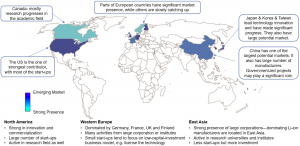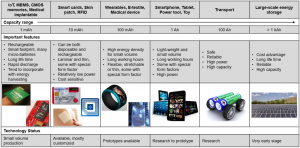
Battery market charging up as industry evolves
EP&T Magazine
Electronics Power Supply / Management IoT Medical Wearable Technology batteries battery battery factors form market market supercapacitorsIDTechEx report shows batteries are moving to new form factors, becoming ultra-thin, flexible, rollable, stretchable
The battery market has suddenly become alive again in recent years, according to a recent report released by research group IDTechEx.
The report states that on one hand, batteries are moving to new form factors, becoming ultra-thin, flexible, rollable, stretchable, etc. On the other hand, manufacturers are scrambling to offer large batteries aimed at addressing the large-sized electric vehicle, residential and grid applications.
The market study from IDTechEx tracks the technology development, market progress and player activities of global flexible, thin-film, printed batteries (or batteries with novel form factors) since 2014.

Market descriptions by territory. Source: IDTechEx
Flexible, thin and/or printed batteries (or batteries with novel form factors) are back on the agenda thanks to the rise of Internet of Things, wearables and environmental sensors. These applications require new features and battery designs that traditional battery technologies simply cannot provide. This has opened the door to innovation and added a new dimension to the global competition between battery suppliers.
Transforming industry
This is a fast-changing industry, with its technologies in a state of rapid progress as new designs, methods and modified chemistries are frequently announced. The business landscape is also being dramatically altered as many companies are now gearing up to progress their lab scale technologies into mass production. These are exciting years for this emerging technology.
The composition of the target market is undergoing drastic change, driven by the emergence of new addressable market categories. Traditionally, the micro-power thin and printed batteries were used in skin patches, RFID tags and smart cards. Today, however, many new emerging applications have appeared, enticing many large players to enter the foray and thus transforming a business landscape that was once populated predominantly by small firms.
The study draws upon at least 27 direct interviews and visits with key suppliers and large end-users from a variety of sectors and years of accumulated experience and market knowledge for the end use applications such as active RFIDs, smart cards, skin patches, smart packaging and recently wearables and IoT.
Complex landscape to navigate
The report indicates that the market and technology landscape is complex, with no black-and-white and clear technology winners and the definition of market requirements is in a constant state of flux.
Indeed, on the technology side, there are many solutions that fall within the broad category of thin film, flexible or printed batteries. These include printed batteries, thin-film batteries, advanced lithium-ion batteries, solid-state batteries, micro-batteries, stretchable batteries, thin flexible supercapacitors and a few more. It is therefore a confusing technology landscape to navigate and betting on the right technology is not straightforward.
On the market side, many applications are still emerging, and the requirements are fast evolving. The target markets are also very diverse and not overlapping, each with different requirements for power, lifetime, thinness, cost, charging cycles, reliability, flexibility, etc. This diversity of requirements means that no thin film battery offers a one-size-fits-all solution.

Applications of batteries with new form and structural factors. Source: IDTechEx
Applications
Wearable technology and electronic textiles are a major growth area for thin film and flexible batteries. Conventional secondary batteries may meet the energy requirements of wearable devices, but they struggle to achieve flexibility, thinness and light weight. These new market requirements open up the space for energy storage solutions with novel form factors. Indeed, the majority of thin-film battery companies tell us that they have on-going projects in the wearable technology field. High-energy thin film batteries have the highest potential here followed by printed rechargeable zinc batteries, provided the latter can improve.
The healthcare sector is also a promising target market. Skin patches using printed batteries are already a commercial reality, while IDTechEx anticipates that the market for disposable medical devices requiring micro-power batteries will also expand. This is a hot space as the number of skin patch companies is rapidly rising. Here, printed zinc batteries have the highest potential but price needs to continue falling before a higher market uptake takes place. Here too, new form factors will be the key differentiator, compared to the high-volume incumbents such as coin cell batteries. Medical diagnostic devices, medical sensors are also promising markets, although the current thin battery technology is not mature enough yet to be applied straightaway.
Wireless sensor/network applications is another important trend especially combining special form factor and harsh temperature requirements. Here, there is a trend to combine energy harvesting with thin batteries with superior form factors.
Active and battery-assisted passive RFID is also a potential target market, although coin-cells are the main solutions unless there is a stringent requirement for laminar or flexible design such as in car plates. It is also in these small niches that thin film batteries might find a place.
Smart cards also remain an attractive sector and several thin-film battery technologies have been optimized to meet the lamination requirements for card manufacture. The price is however too steep to enable widespread market penetration. The emerging of online and mobile banking carries a long-term threat of substitution.
